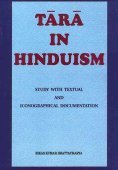Rudrayamala, Rudrayāmala, Rudra-yamala: 8 definitions
Introduction:
Rudrayamala means something in Hinduism, Sanskrit. If you want to know the exact meaning, history, etymology or English translation of this term then check out the descriptions on this page. Add your comment or reference to a book if you want to contribute to this summary article.
In Hinduism
Shaktism (Shakta philosophy)
Source: DSpace at Pondicherry: Siddha Cult in Tamilnadu (shaktism)Rudrayāmala (रुद्रयामल).—The Rudrayāmala is an extensive work in sixty-six chapters and has over 6,000 verses. One of the important features of this work is that it contains a panegyric of Atharva Veda saying that all gods, all beings, all sages along with Kāmavidyā and Mahāvidyā dwell in it. It deals with the mysterious Kuṇḍalini, Yogic practices, and the six cakras in the body. It also prescribes sexual union and the use of wine; it states that a vīra should drink wine and use a beautiful woman who is capable of arousing sexual passion. It also mentions about some important Śakta Pīthas.

Shakta (शाक्त, śākta) or Shaktism (śāktism) represents a tradition of Hinduism where the Goddess (Devi) is revered and worshipped. Shakta literature includes a range of scriptures, including various Agamas and Tantras, although its roots may be traced back to the Vedas.
Ayurveda (science of life)
Dietetics and Culinary Art (such as household cooking)
Source: Shodhganga: Dietetics and culinary art in ancient and medieval IndiaRudrayāmala (रुद्रयामल) is the author of the Takravidhi: a Sanskrit book dealing with the topics of dietetics and culinary art, also known as Pākaśāstra or Pākakalā.—It is a noticeable fact that Āyurveda and its tradition, stood as the champions for the development of critical notions of dietetics and culinary art in ancient and medieval India. [...] Ravindra Kumar Panda states that Suṣeṇa has written a work on food science known as Vyañjanavarga. According to him, other works on food science are [for example]: Takravidhi of Rudrayāmala.

Āyurveda (आयुर्वेद, ayurveda) is a branch of Indian science dealing with medicine, herbalism, taxology, anatomy, surgery, alchemy and related topics. Traditional practice of Āyurveda in ancient India dates back to at least the first millenium BC. Literature is commonly written in Sanskrit using various poetic metres.
General definition (in Hinduism)
Source: Shiva Shakti: Rudrayamala UttarakhandaThe Rudrayamala is used as a source by many other agamas but the original appears to be lost. Strictly speaking, a Yamala is a different class of text, and supposed to pre-date the tantras. However, manuscripts of the Yamala seem to be lost, except as quotations in later works.
Languages of India and abroad
Sanskrit dictionary
Source: DDSA: The practical Sanskrit-English dictionaryRudrayāmala (रुद्रयामल).—Name of a Tantra (a dialogue between bhairava and bhairavī).
Derivable forms: rudrayāmalam (रुद्रयामलम्).
Rudrayāmala is a Sanskrit compound consisting of the terms rudra and yāmala (यामल).
Source: Cologne Digital Sanskrit Dictionaries: Aufrecht Catalogus CatalogorumRudrayāmala (रुद्रयामल) as mentioned in Aufrecht’s Catalogus Catalogorum:—tantra in 64 Paṭala. Hpr. 1, 323. Hz. 964 (inc.). Rudrayāmale Aghoramantrasādhanaprakāra. L.. 363, 1.
—Adhimāsanirṇaya. L.. 329.
—Ayodhyāmāhātmya. Ak 112. As p. 13.
—Āpaduddhārabaṭukabhairavastavarāja. L.. 1231 -1235.
—Kālikākavaca Āpaduddhāraṇa. L.. 1290, 16.
—Kālīkavaca Vajrapañjara. L.. 1290, 6.
—Kālīpūjāpaddhati. Cs 5, 77.
—Gāṇapatisahasranāman. Bd. 961.
—Gāyatrīkavaca. L.. 1221, 3.
—Gāyatrīpaṭala. L.. 1221, 1.
—Gāyatrīrahasya in 4 parts. L.. 1221.
—Gāyatrīsahasranāman. Hpr. 2, 51. L.. 1223.
—Gāyatrīstava. L.. 1221, 4.
—Gurustotra. L.. 1224.
—Jvālākavaca. Cs 5, 78.
—Jvālāpaṭala. Cs 5, 80.
—Jvālāmukhīstavarāja. Cs 5, 79.
—Jvālāsahasranāman. Cs 5, 81.
—Turīyātripurāsahasranāman. L.. 1225.
—Tripurasundarīsahasranāman. L.. 1227.
—Tripurasundarīstavarāja. Cs 5, 35.
—Trailokyamohanakavaca. Cs 5, 35. Hz. 1204. L.. 1290, 9.
—Trailokyamohana Kālikākavaca. L.. 1290, 7.
—Dakṣiṇakālīkavaca. L.. 1228.
—Dattātreyahṛdaya. Hpr. 2, 96.
—Devīsūktavarṇana. L.. 1229.
—Navagrahabījamantra. As p. 89.
—Navagrahastava. As p. 89.
—Nityapūjāpaddhati. L.. 1221, 2. 1222 ([fragmentary]).
—Pañcacakrapūjana. Cs 5, 52 (inc.).
—Paramahaṃsapañcāṅga. Hpr. 2, 125.
—Pārthivapūjā. L.. 363, 1.
—Pārthiveśvarapūjāvidhi. Cs 2, 358.
—Pārthiveśvaraprayogapaddhati. L.. 1330.
—Baṭukabhairavasahasranāman. L.. 1230.
—Bālabhairavīsahasranāmastotra. Hpr. 1, 246.
—Bālātripurātrailokyavijayakavaca. L.. 1237.
—Bālātripurānāmasahasra. L.. 1226.
—Bālāsahasranāmastotra. Cs 5, 92. L.. 1238. Rudrayāmale Bhavānīkavaca. L.. 1239.
—Bhavānīsahasranāman. Hz. 1202. Il. Io. 1846. No. 3934. L.. 1240-1242. 1243, 1. 1244. 1245 (inc.).
—Bhuvaneśvarīrahasya. As p. 134.
—Meghamālā. As p. 152. Cs 5, 82. L.. 1246. Peters. 6, 434.
—Rāmacandrasahasranāman. L.. 1247. 1248.
—Rāmasahasranāmastotra. Peters. 6, 509.
—Rudracaṇḍikā. Hpr. 1, 322.
—Vagalāmukhītrailokyavijayakavaceśa. L.. 1368.
—Vagalāmukhīstotra. L.. 1367.
—Śāpamocana. L.. 1290, 18.
—Śivakavaca. L.. 363, 1.
—Śivasahasranāmastotra. Hpr. 2, 215.
—Śyāmāṣṭottarasahasranāman. L.. 1249.
—Sadāśivastotra. L.. 363, 1.
—Sarasvatīpaṭala. As p. 215.
—Sarasvatīpūjāpaddhati. As p. 215.
—Sarasvatīstotra. As p. 215. Bṛhadrudrayāmale Kṛṣṇanāradasaṃvāde Janmakhaṇḍaḥ. Hpr. 1, 250.
Rudrayāmala (रुद्रयामल):—[=rudra-yāmala] [from rudra > rud] n. Name of a Tantra [work] in the form of a dialogue between Bhairava and Bhairavī
[Sanskrit to German]
Sanskrit, also spelled संस्कृतम् (saṃskṛtam), is an ancient language of India commonly seen as the grandmother of the Indo-European language family (even English!). Closely allied with Prakrit and Pali, Sanskrit is more exhaustive in both grammar and terms and has the most extensive collection of literature in the world, greatly surpassing its sister-languages Greek and Latin.
See also (Relevant definitions)
Partial matches: Yamala, Rudra.
Starts with: Rudrayamaladisamgraha, Rudrayamalatantra.
Full-text (+312): Samaravijaya, Rudracandi, Makaradisahasranaman, Rudrayamalatantra, Sharikakavaca, Rudrayamaliyacikitsa, Rudrayamaladisamgraha, Shivabali, Bhavanipancanga, Bhuvaneshvaripancanga, Paramahamsapancanga, Pratyangirapancanga, Bhuvaneshvarirahasya, Indrakshipancanga, Bhavanikavaca, Jvalamukhistavaraja, Pancacakrapujana, Vagalamukhistotra, Gurupatala, Lakshminarayanapancanga.
Relevant text
Search found 10 books and stories containing Rudrayamala, Rudra-yamala, Rudra-yāmala, Rudrayāmala; (plurals include: Rudrayamalas, yamalas, yāmalas, Rudrayāmalas). You can also click to the full overview containing English textual excerpts. Below are direct links for the most relevant articles:
Shat-cakra-nirupana (the six bodily centres) (by Arthur Avalon)
Cidgaganacandrika (study) (by S. Mahalakshmi)
Part 2 - Emergence of Śaiva philosophy < [Philosophy of Kashmir Tantric System]
Varahi Tantra (English Study) (by Roberta Pamio)
Maha Kassapa (by Hellmuth Hecker)
Puranic encyclopaedia (by Vettam Mani)
Gitartha Samgraha (critical Study) (by Partha Sarathi Sil)
Related products

